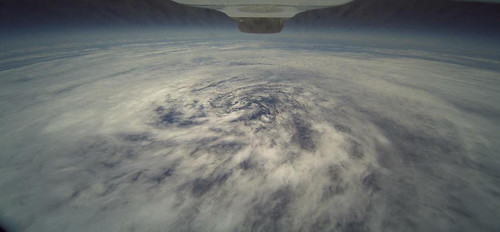 Researchers have detected the presence of a pollutant-destroying compound iodine monoxide in surprisingly high levels high above the tropical ocean, according to a new study led by the University of Colorado Boulder's Cooperative Institute for Research in Environmental Sciences.
Researchers have detected the presence of a pollutant-destroying compound iodine monoxide in surprisingly high levels high above the tropical ocean, according to a new study led by the University of Colorado Boulder's Cooperative Institute for Research in Environmental Sciences."The levels of IO we observed were much higher than expected," said Rainer Volkamer, a CIRES fellow and principal investigator of the study. "The high concentrations in air that has not recently been in contact with the ocean surface point to the intriguing possibility of a recycling mechanism whereby instead of IO decaying away as previously thought, it's released back to the atmosphere by heterogeneous chemistry on aerosol particles."
IO is an important chemical because it destroys ozone, a greenhouse gas that warms the planet and also indirectly lowers methane levels, said Volkamer, also an assistant professor of chemistry and biochemistry. Additionally, IO can form aerosols—tiny particles suspended in the atmosphere that can initiate the production of clouds that can help cool the climate.
If IO is recycled in the atmosphere, as the research findings suggest, "It means IO has a longer effective lifetime and is, thus, much more broadly distributed, affects a much broader atmospheric air mass, and can destroy much more ozone," Volkamer said.
The team's analysis indicates that IO accounts for up to 20 percent of the overall ozone loss rate in the upper troposphere (the layer of the atmosphere extending from Earth's surface up to about 60,000 feet). This ozone sink is currently missing in most atmospheric models. The origin of IO is thought to be iodine emitted by microalgae or inorganic reactions at the ocean surface. Because IO occurs in relatively very small concentrations—one in 1013 molecules—it previously had been impossible to quantify the amount in the upper atmosphere.
Volkamer's team, however, solved that problem. They built an instrument— the University of Colorado Airborne Multi-Axis Differential Optical Absorption Spectroscopy (CU AMAX-DOAS) instrument—attached it to a research plane, and flew it over the tropical Pacific during January 2010, collecting and analyzing air samples from about 300 feet up to 33,000 feet to create a vertical profile of the atmosphere's composition. The efforts marked the first aircraft measurements of IO, and the results appeared online Jan. 23 in the Proceedings of the National Academy of Sciences.
During the flight, the researchers studied both stable, aged air, which has had no contact with the ocean surface in days, and a deep convective storm, which pumps warm, moist air from the ocean surface into the upper troposphere. Because IO has a very short lifetime in the atmosphere—it lasts only 30 to 60 minutes before forming aerosol particles—the researchers expected to find IO only near the ocean surface and in the storm cell, which acts like a "large vacuum cleaner, sucking air from the ocean surface up to 30,000 feet in as little as 20 minutes," Volkamer said.
Instead, they discovered high levels of IO even in aged air that had not connected with the ocean for several days. "Based on current understanding, iodine oxide shouldn't be hanging around for more than one hour," Volkamer said. "But these measurements reveal a surprising persistence of IO in air masses disconnected from the ground. We don't see that the IO decays away. It still hangs around." The persistence of IO suggests that IO isn't irreversibly lost to aerosol, Volkamer said. The aerosol "returns" the IO to the atmosphere. Such a recycling mechanism would be novel because iodine is a very heavy atom. "It's like a cannonball," Volkamer said. "It tends to form polymers and stick onto particles. But a portion seems to be returning into the gas phase."
Such a recycling mechanism would extend the effective lifetime of IO, increasing the amount of ozone it destroys. The findings will help improve climate models' predicative capability about how atmosphere behaves and how the atmosphere cleanses itself of pollutants and greenhouse gases, Volkamer said.
The next step will be to elucidate the mechanisms behind IO's high concentrations. "It's exciting because the atmosphere has more cleansing mechanisms than we suspected," Volkamer said.
Source: Phys.org
Journal reference: Proceedings of the National Academy of Sciences
Photo courtesy of NASA via Flickr (CC BY 2.0)
